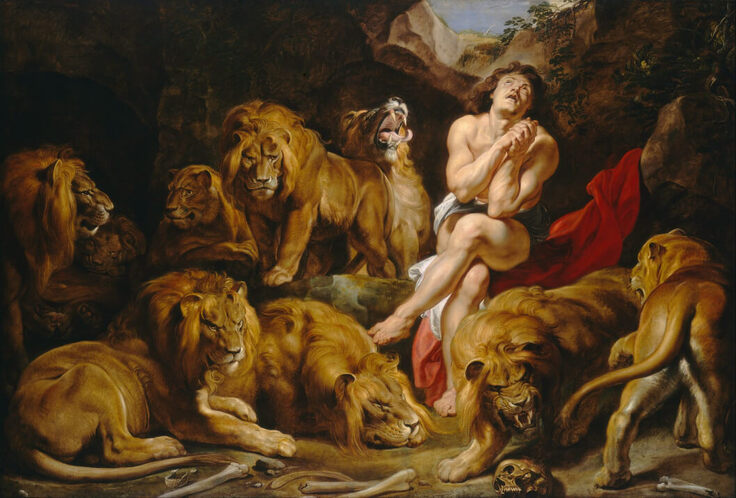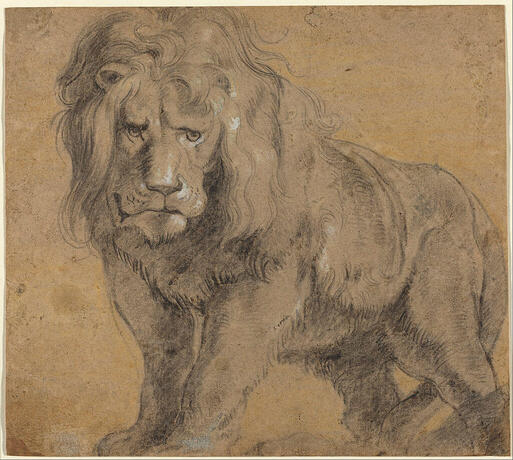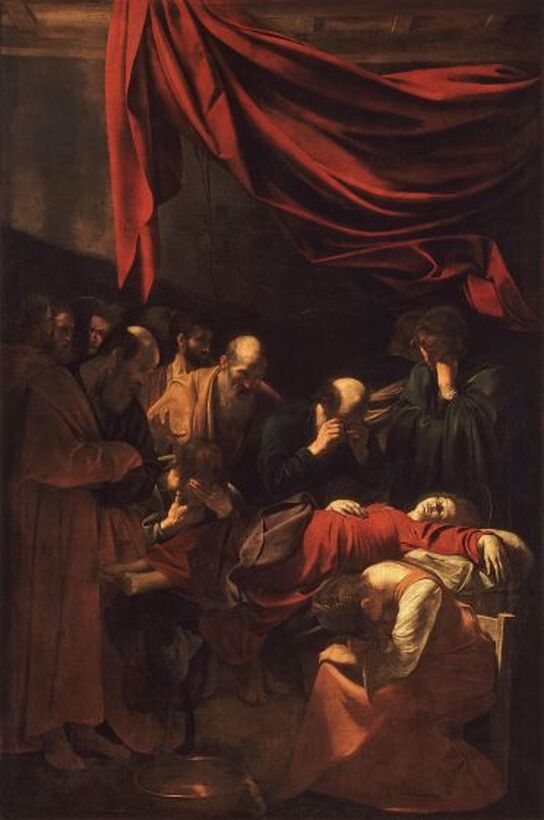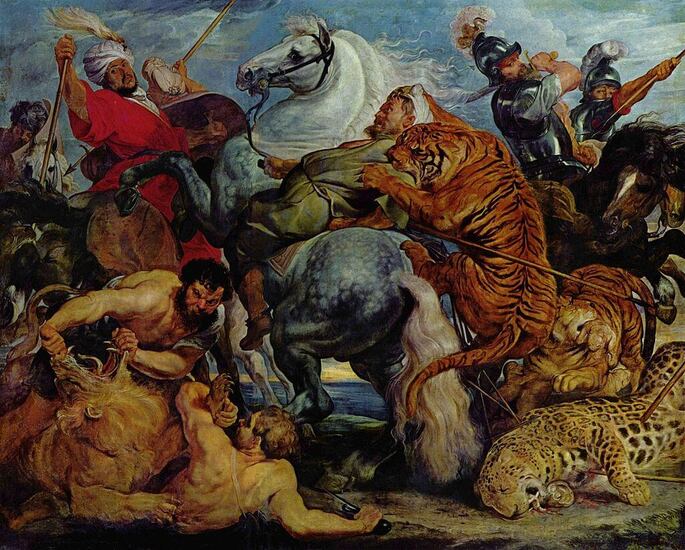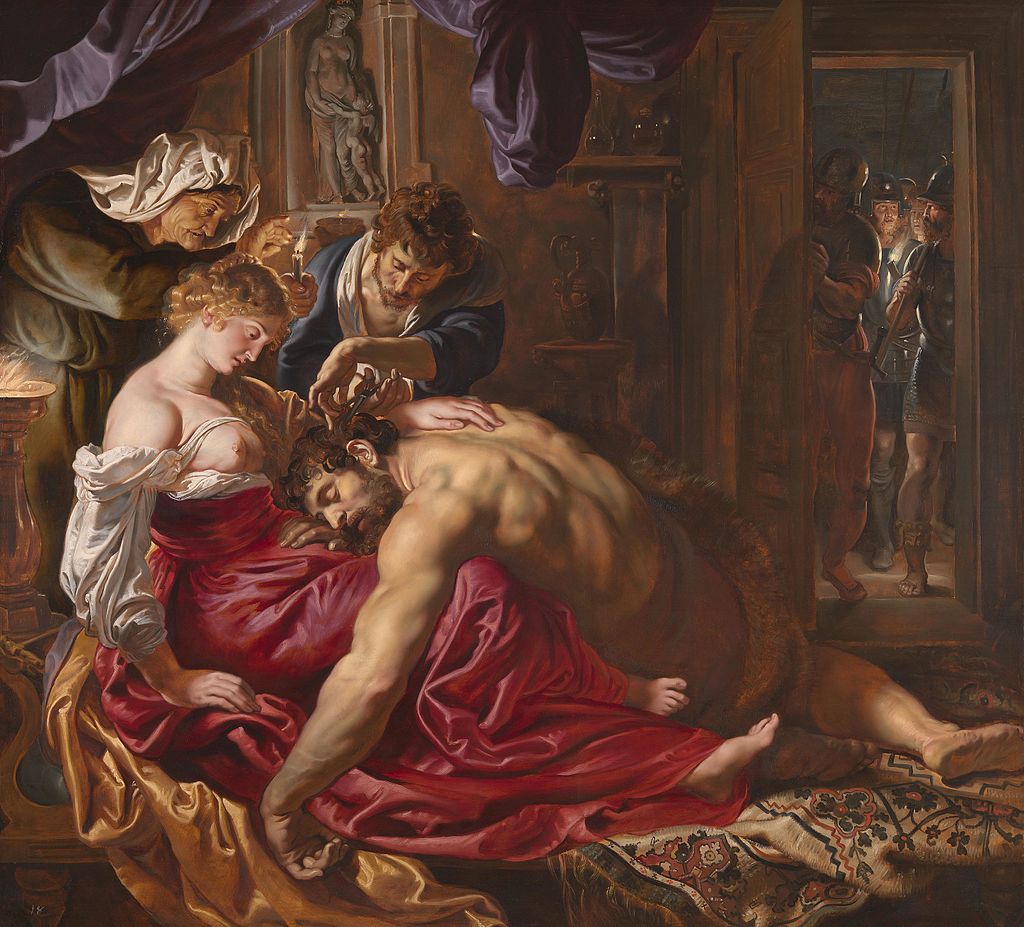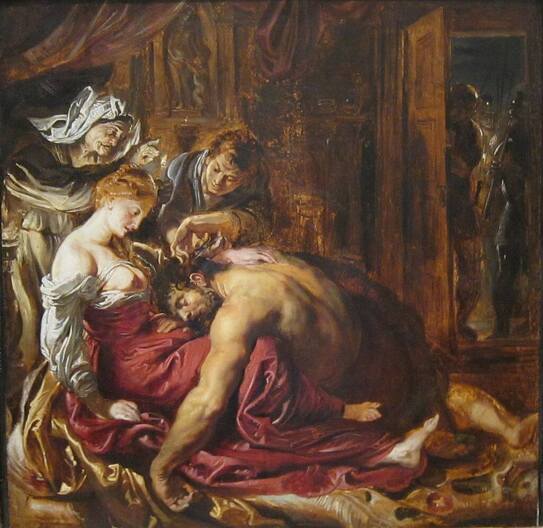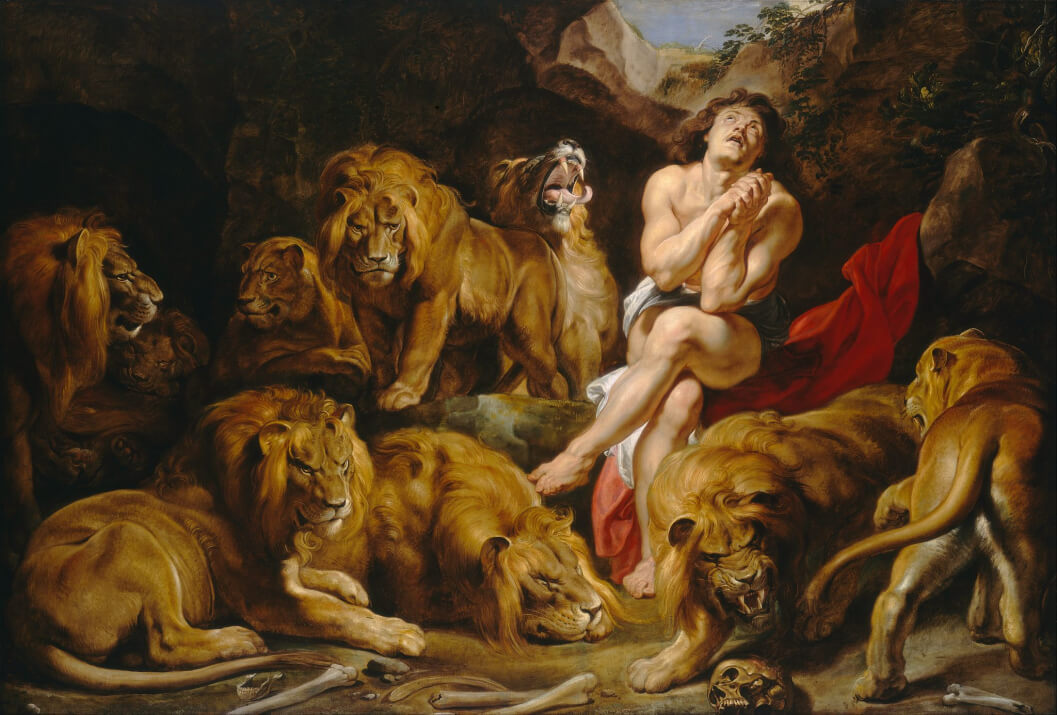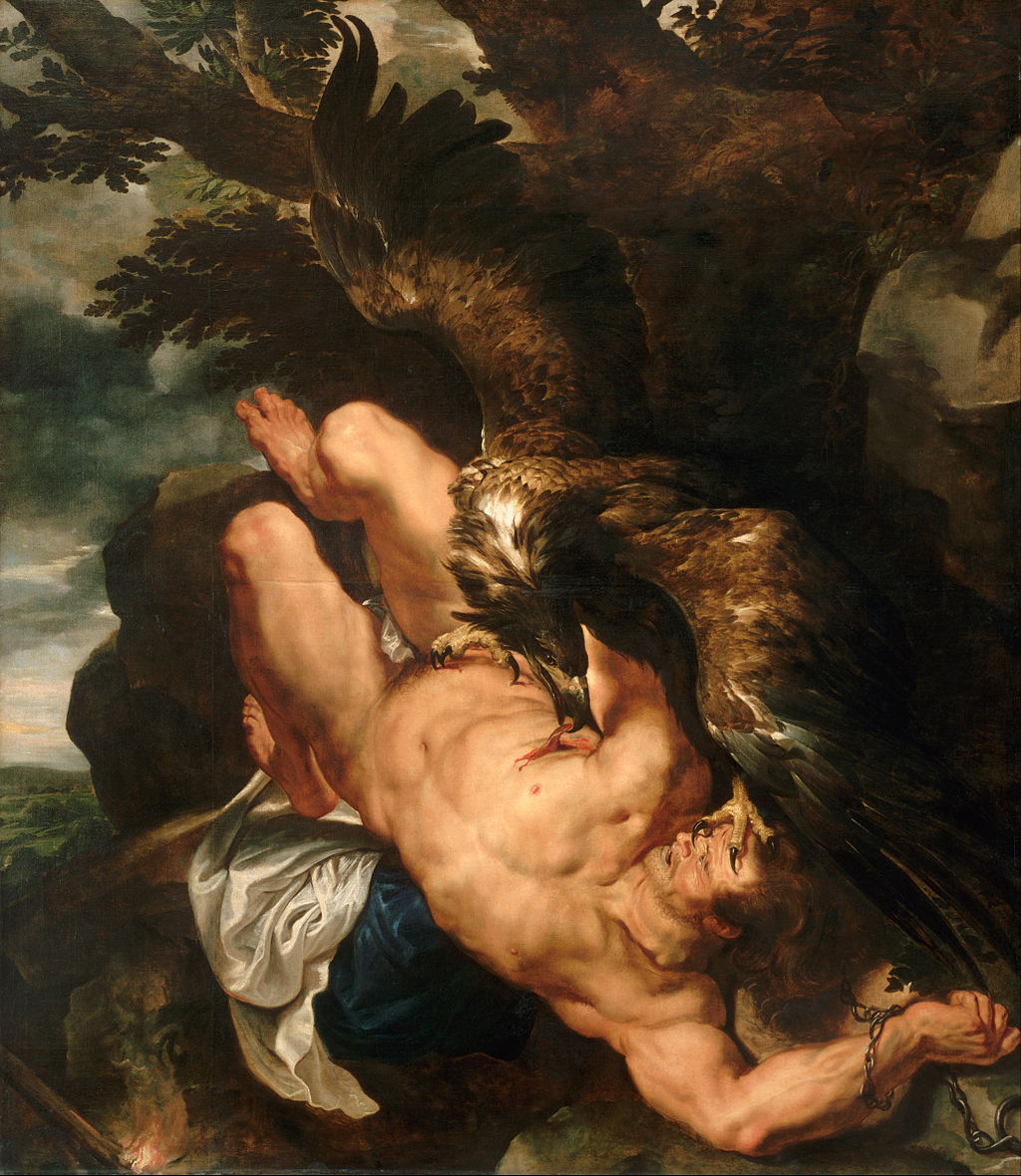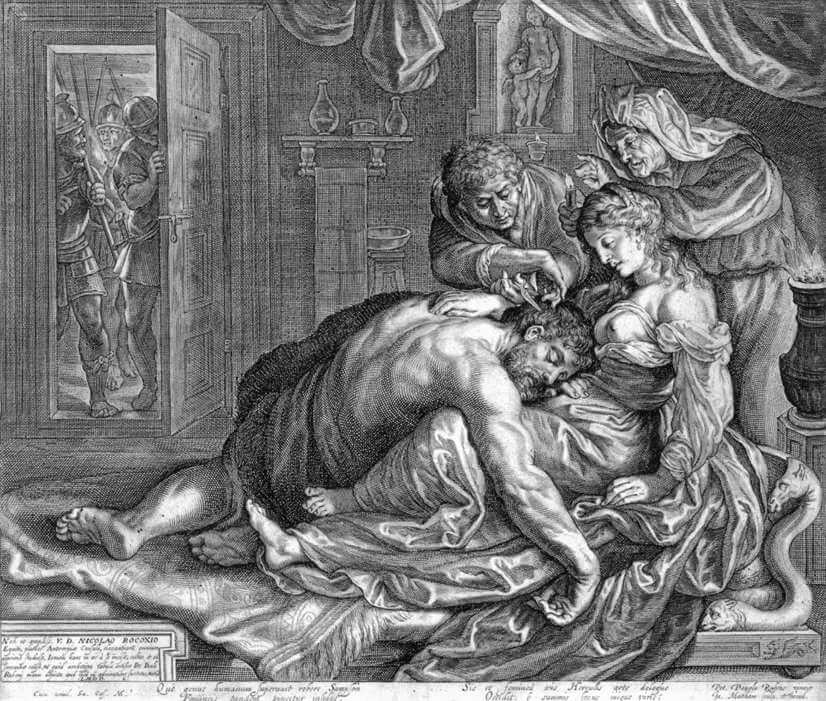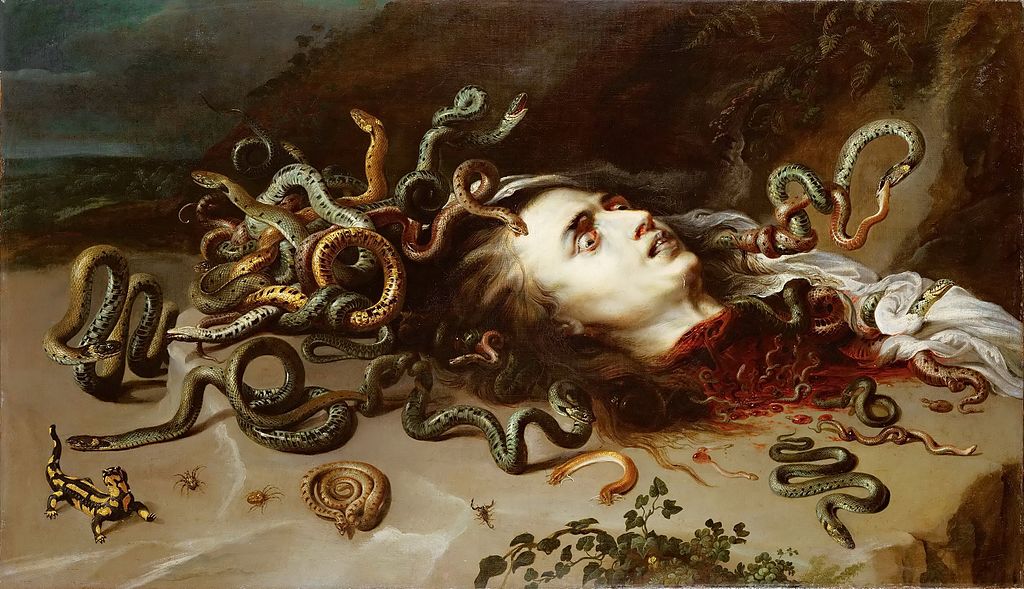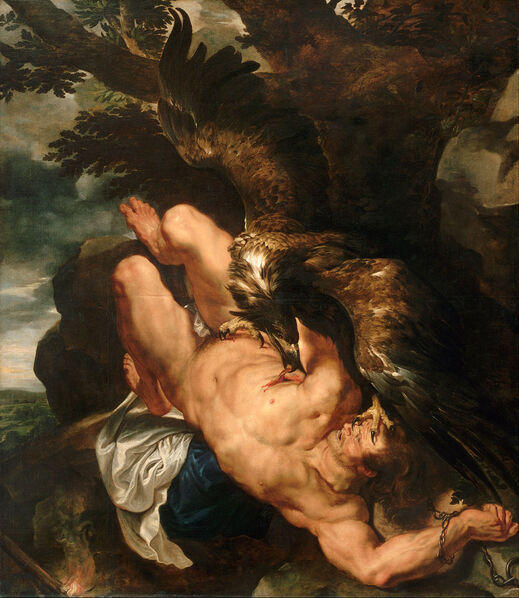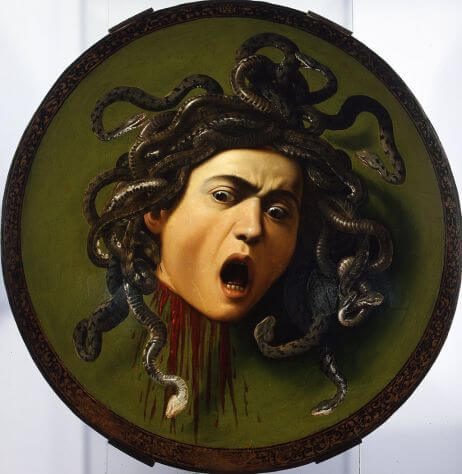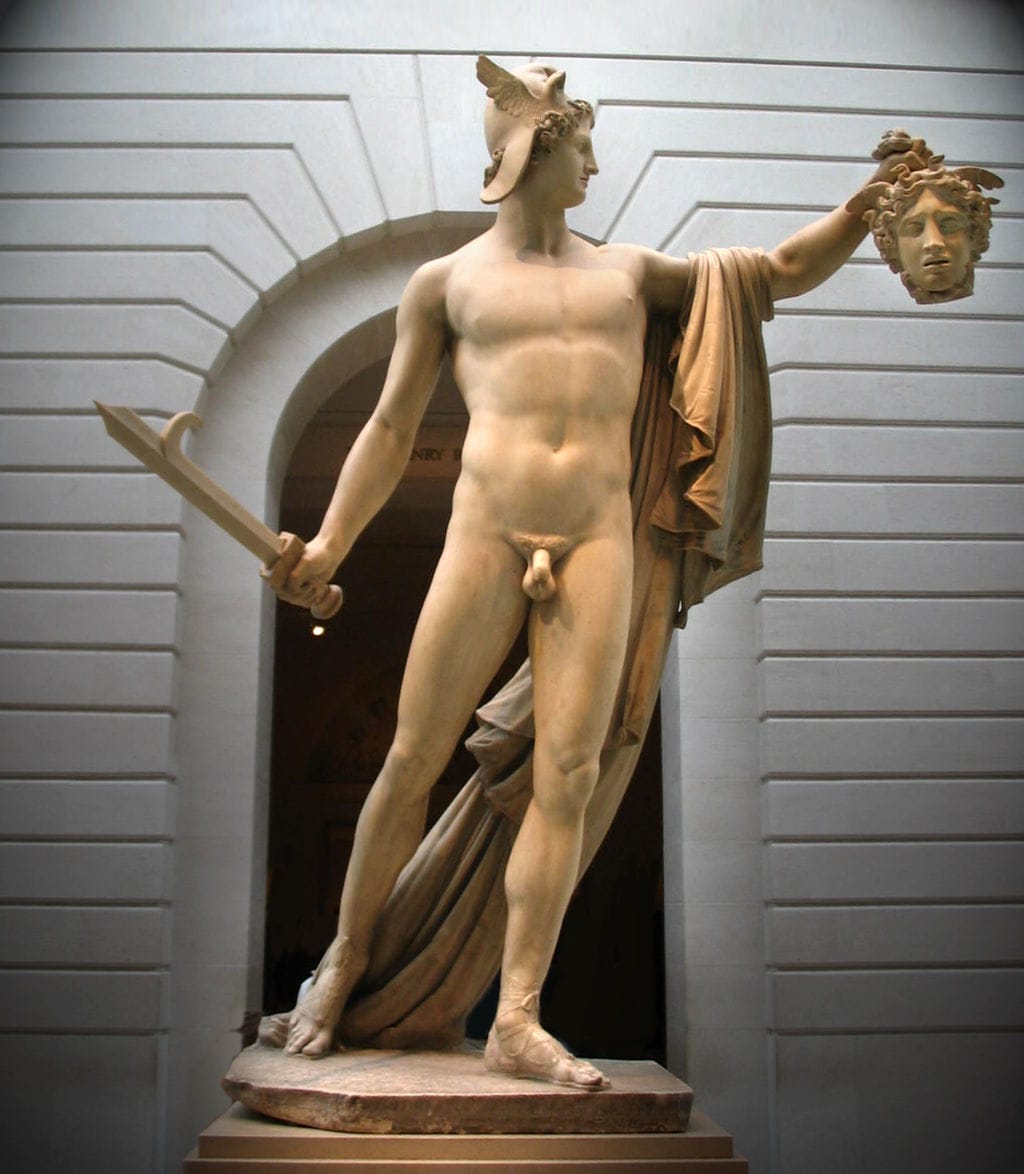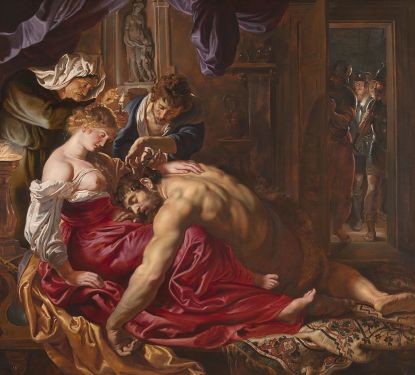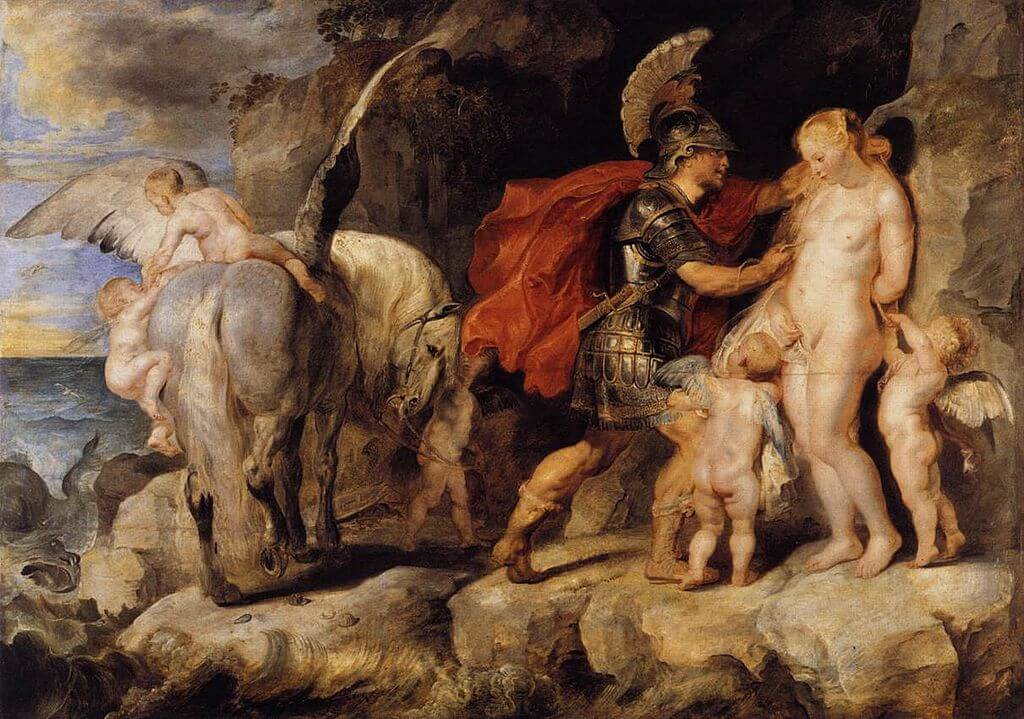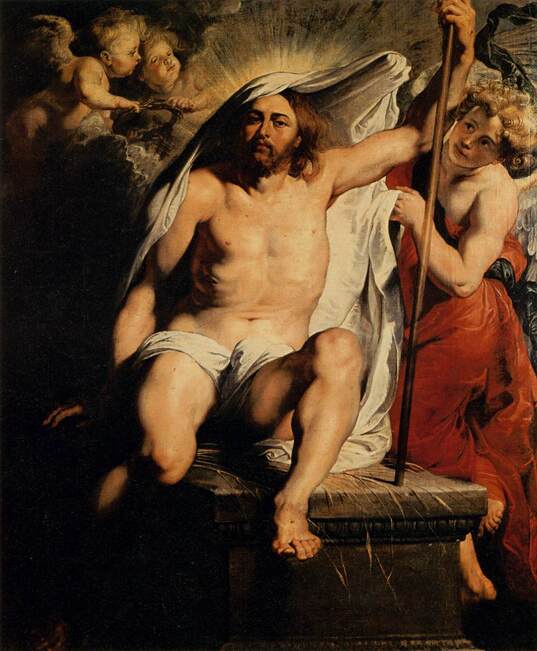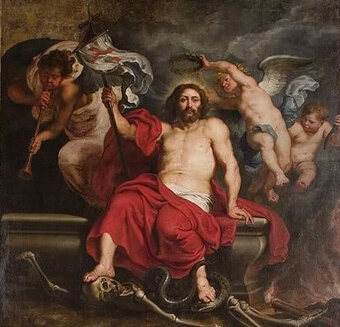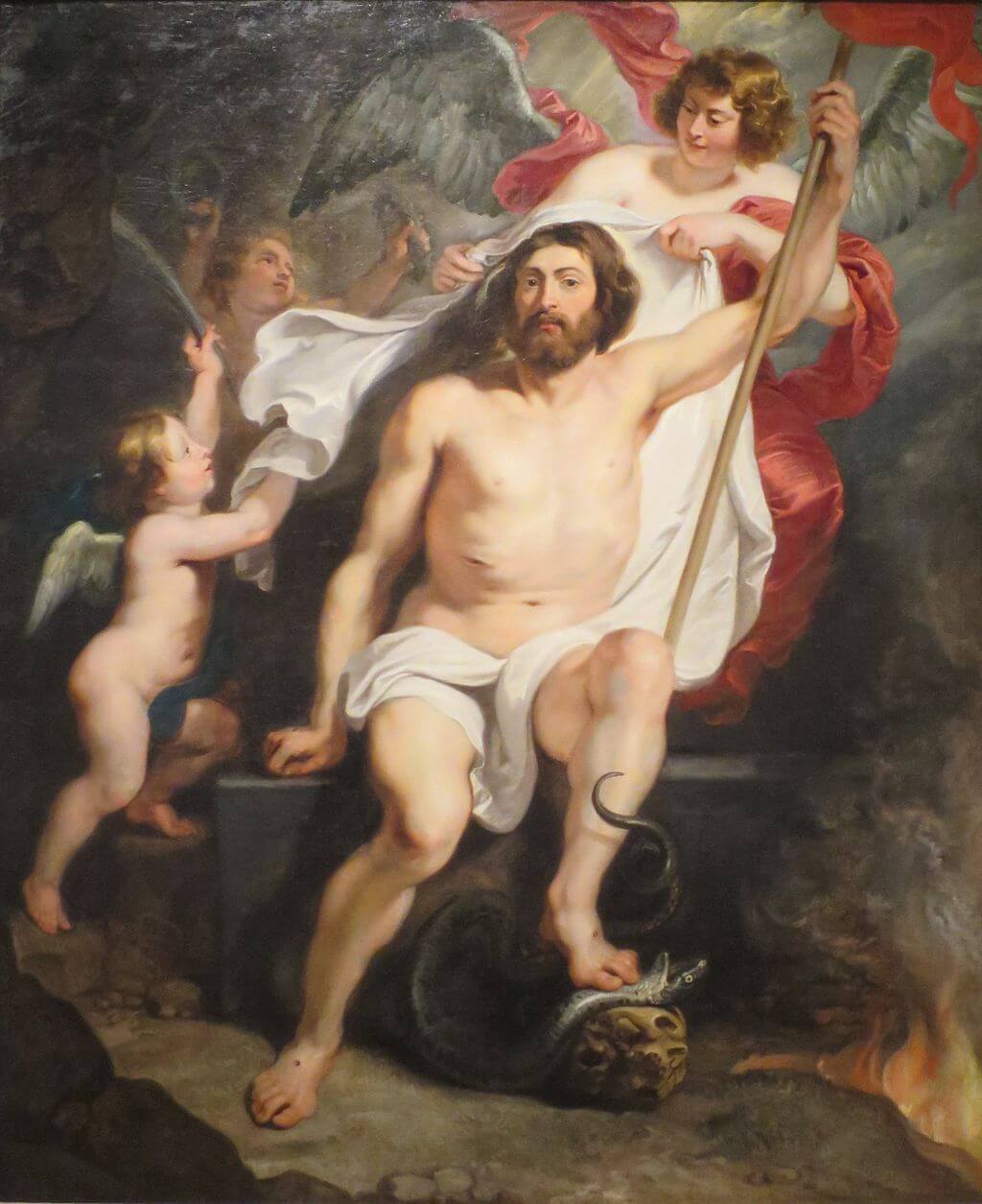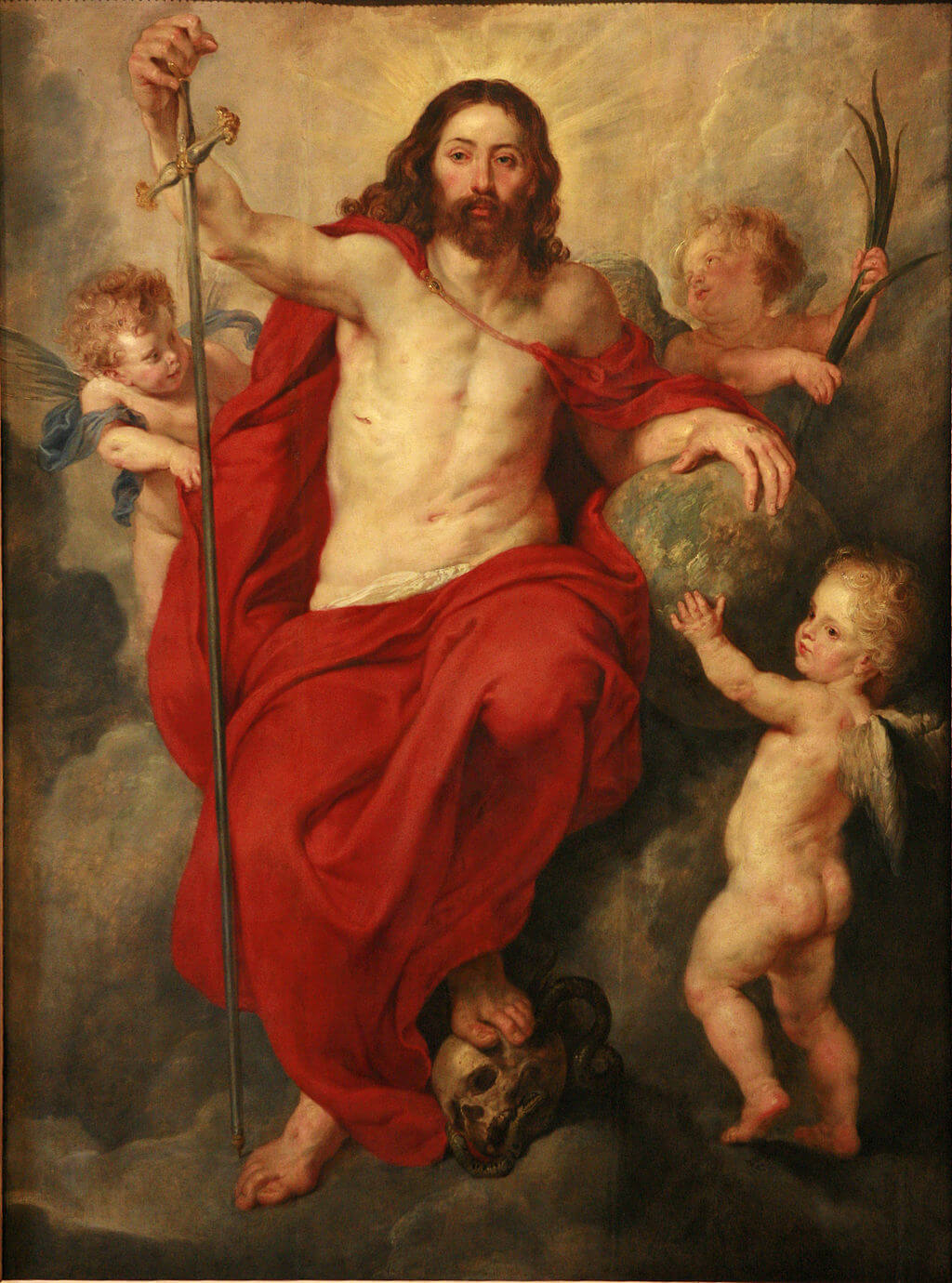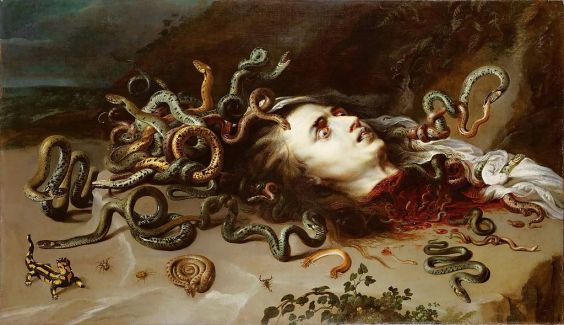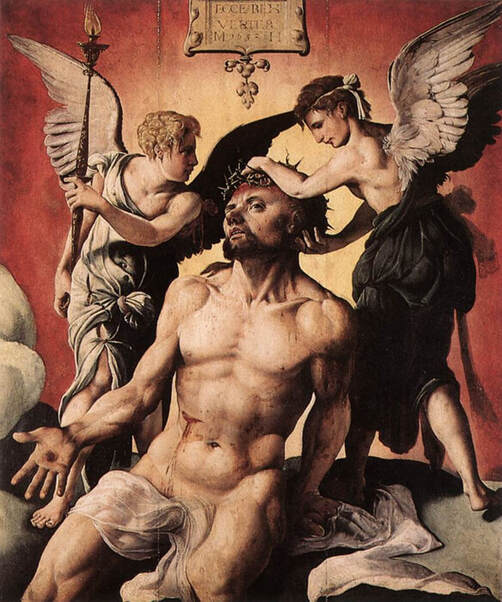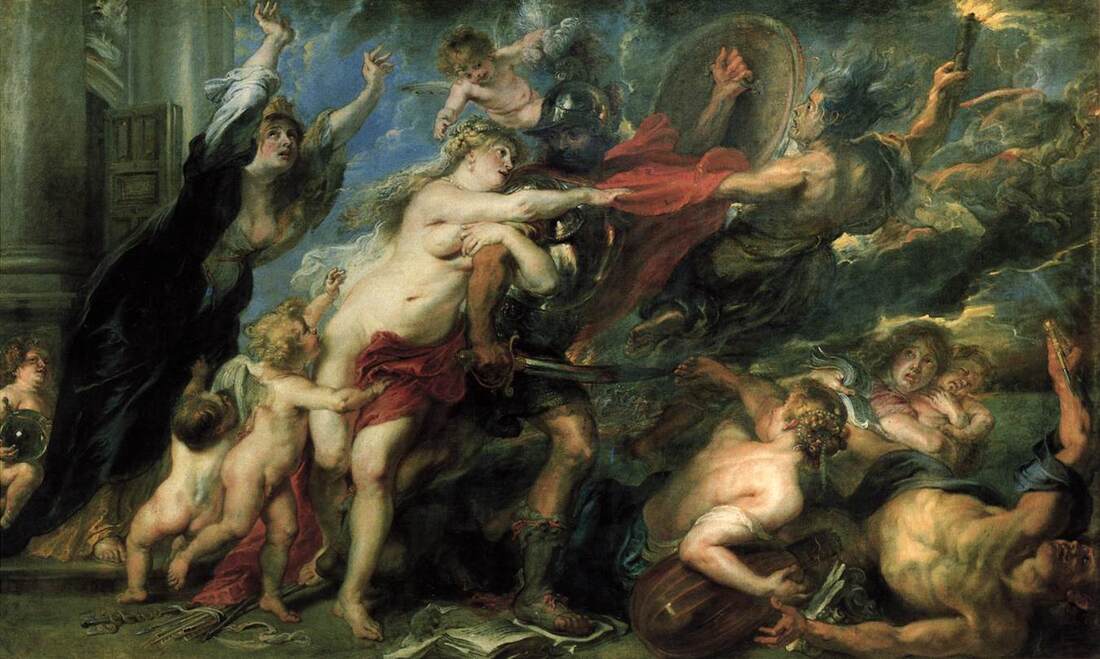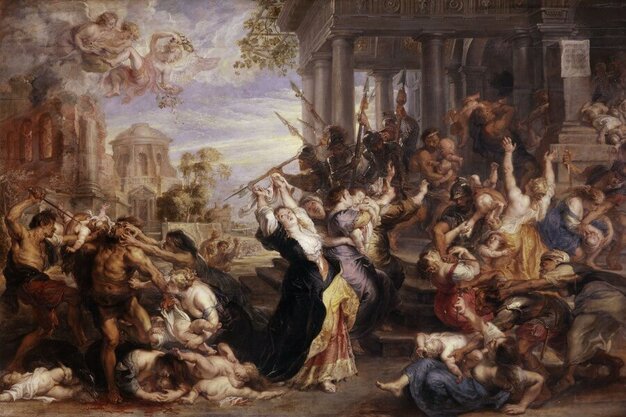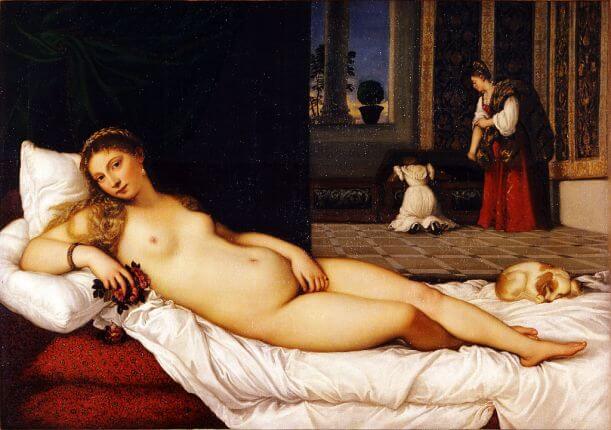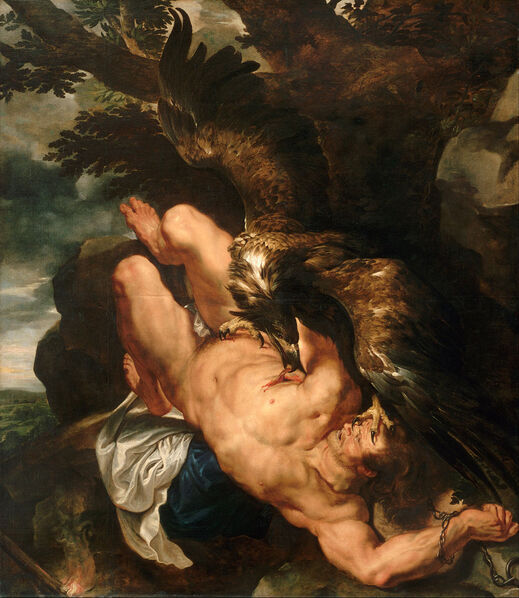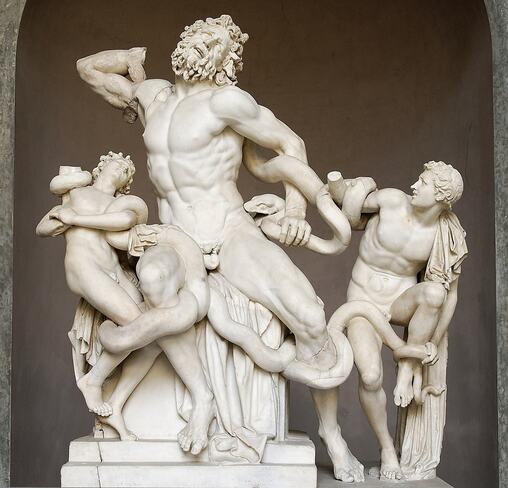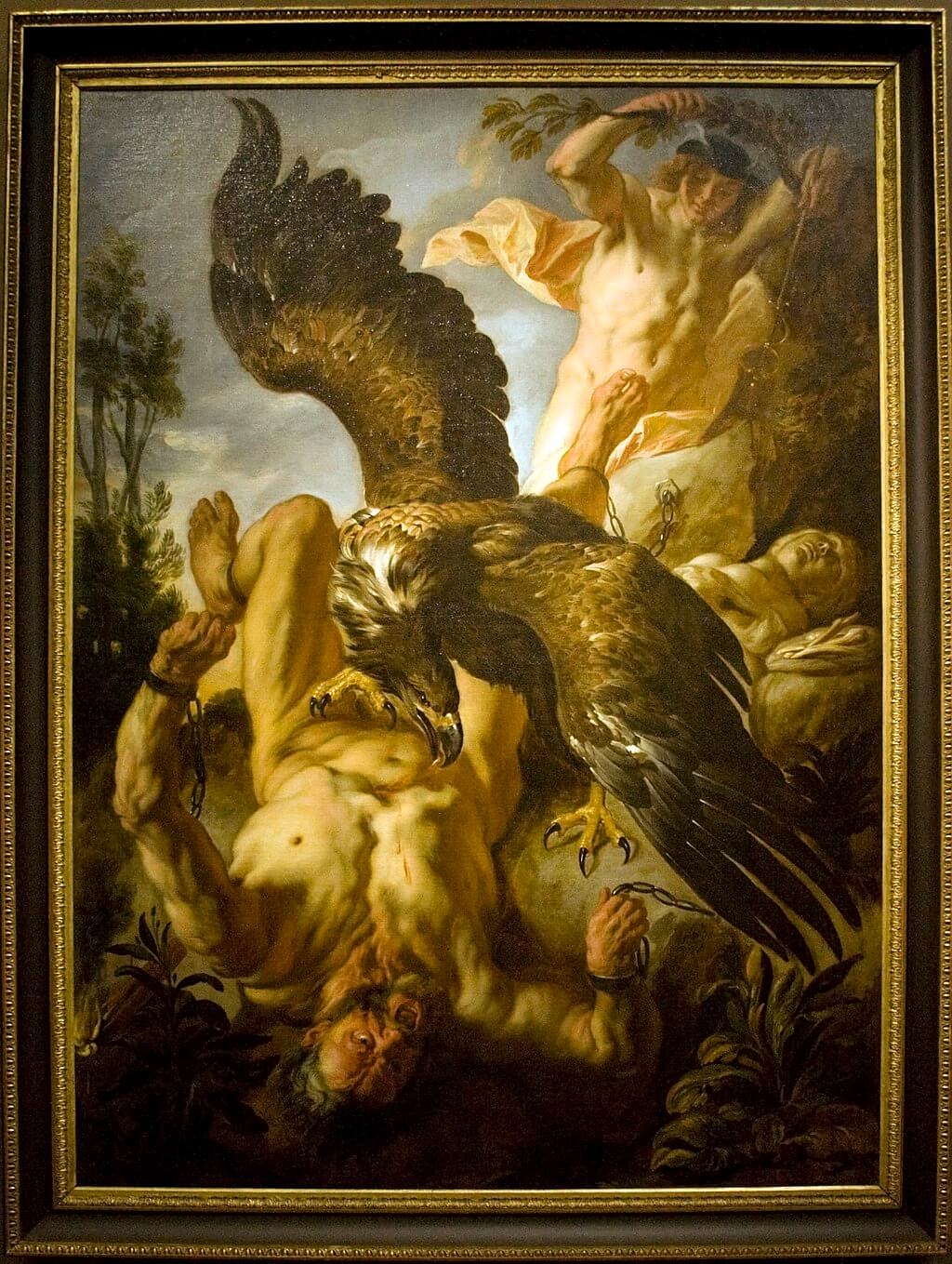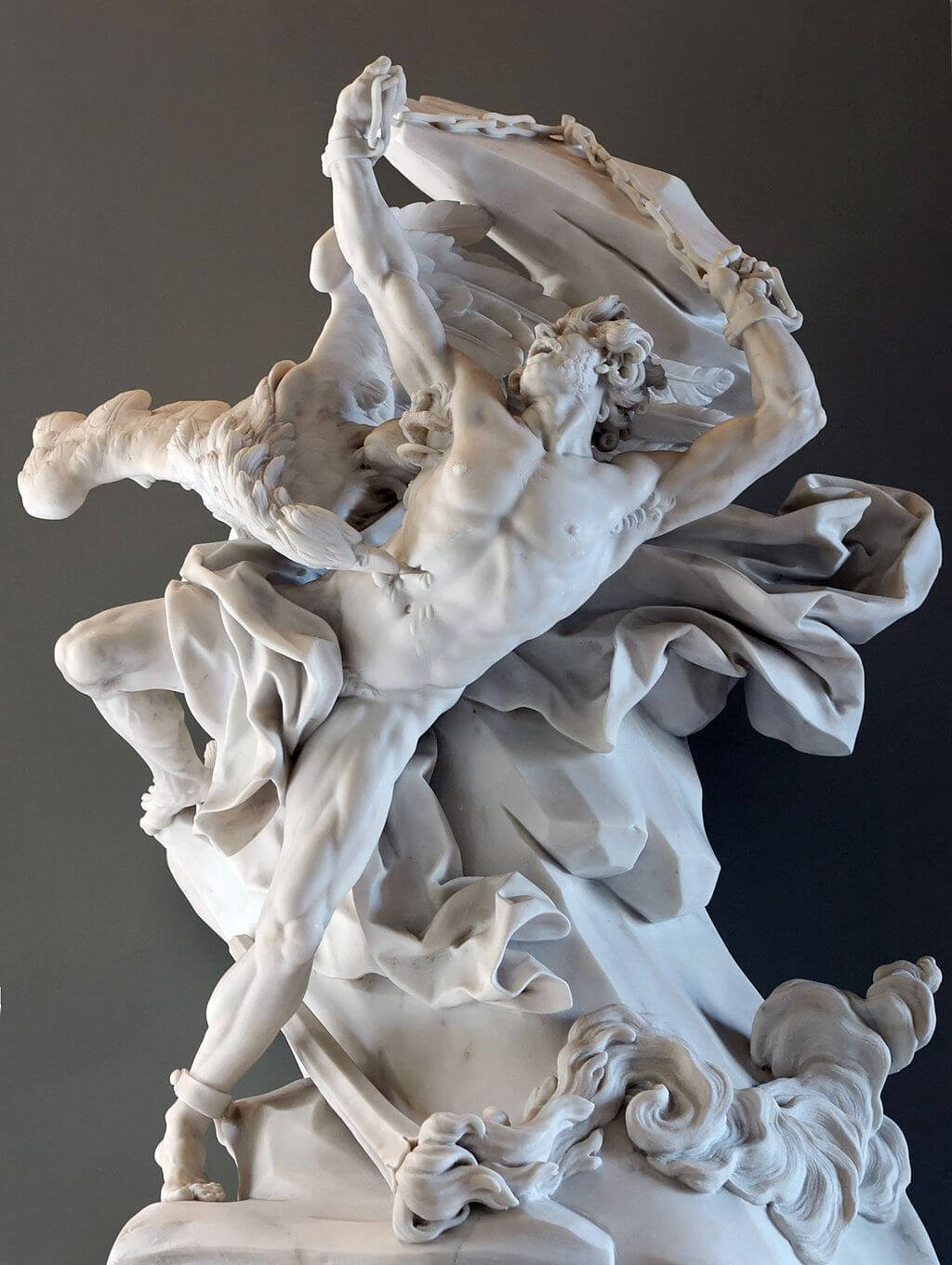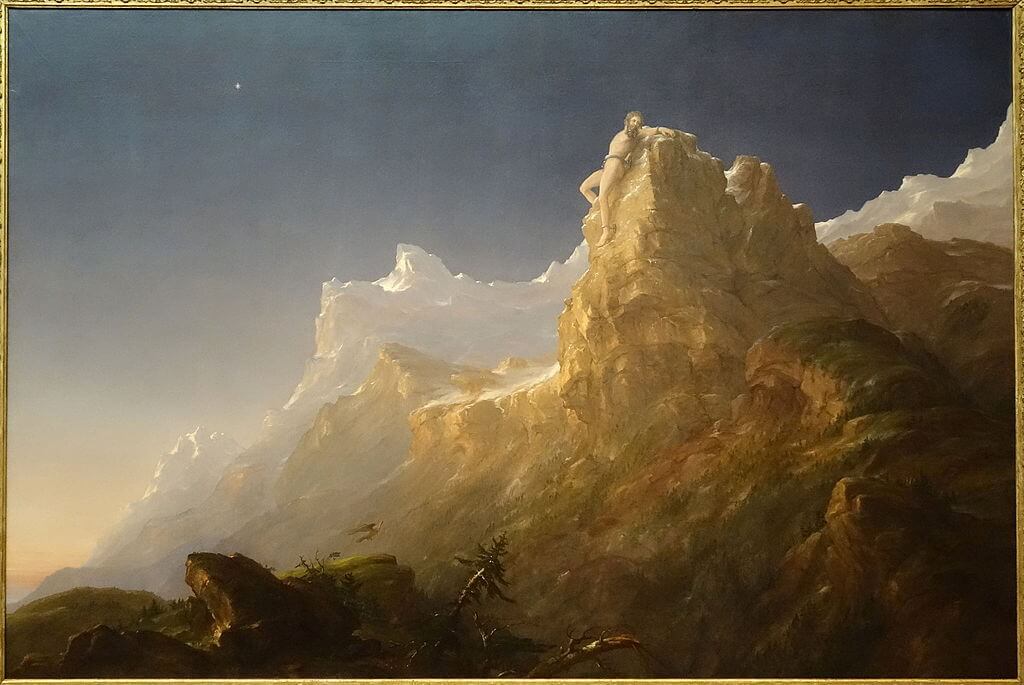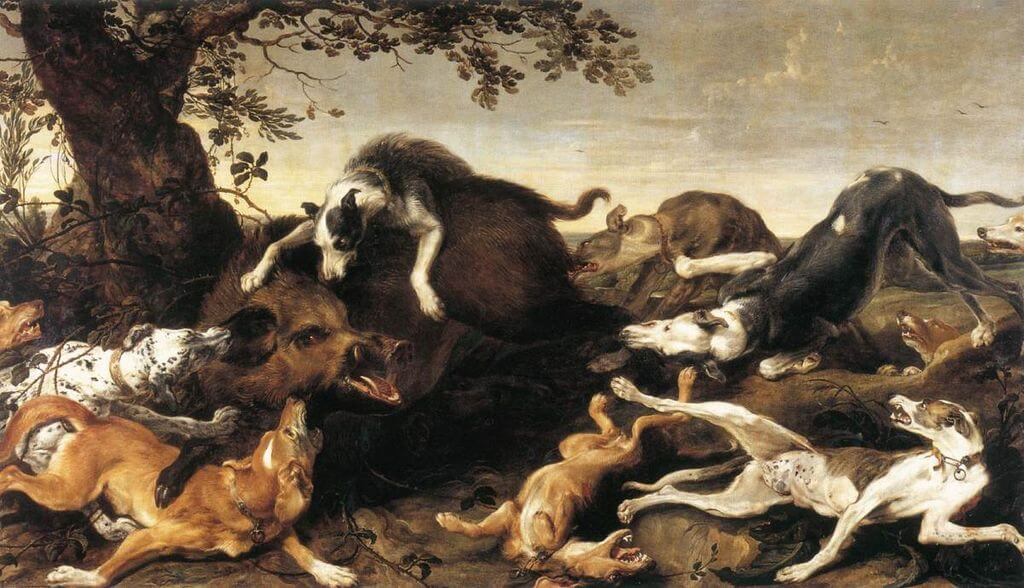|
Where? Gallery 45 of the National Gallery of Art
When? 1614-1618 Commissioned by? Unknown, but possibly Rubens created this as a showpiece for his studio. What do you see? Daniel is in the lions’ den surrounded by life-size lions. He sits on a colorful red cloth and has a white cloth wrapped around him. His body is tense with his legs crossed and his arms together. Given the light in the background, it seems that this painting captures the moment in the morning after Daniel has spent a full night in the den. Daniel is praying with his hands folded and he is looking up into the air. Some lions are sleeping, others are looking straight at us, and others are roaring or growling. There are nine lions and lionesses. In the foreground are the bones and a skull as evidence that the lions have already eaten some people. However, a young Daniel is sitting alive in the middle of the den. Notice that according to the Biblical story, Daniel was much older when he was thrown into the lions’ den, probably around 80 years old.
The painting is based on the Biblical story in the Book of Daniel, chapter 6. In short, Daniel is a high-level administrator for the Persian king Darius. He is doing so well that Darius wants to promote Daniel to be in charge of the full kingdom. The other administrators hatch a plan to trap Daniel. They convince Darius to issue a decree that in the next 30 days no one could pray to any god or human other than king Darius. As Daniel continues to pray to his God, he is sentenced to be thrown into the lions' den which nobody could survive. Darius says to Daniel before he is thrown in the den: “May your God, whom you serve continually, rescue you!” A big stone then covers the den.
The next morning Darius checks on Daniel and finds him still alive without any scratch. After that, Darius decided to throw all the administrators and their families in the lions’ den next, and they were all killed before they even reached the floor. Symbolism: The message of this painting reflects the message from the Biblical story of Daniel in the lions’ den: If you trust in God, he will protect you from no matter what, even from a pride of hungry lions. This story also symbolizes the resurrection of Jesus from the dead. The lions symbolize the powerful rulers on earth. Daniel is praying and looking upwards to Heaven, which symbolizes his faith in God. The skull in the foreground refers to Golgotha, the place where Jesus was crucified. The red cloth refers to the blood of Jesus.
Who is Rubens? Peter Paul Rubens (1577-1640) is a Flemish painter. He was born in Siegen, which is now in Germany, and died in Antwerp, Belgium. Together with Caravaggio, Rubens was one of the most well-known painters of his time. He used a Baroque style of painting.
In 1600, Rubens traveled to Italy, where he stayed for eight years. He spent time in Venice, Florence, and Rome and got inspired by the works of artists like Michelangelo, Raphael, and Titian. After this period he moved back to Belgium, where he set up his studio. Together with his many students and apprentices, he produced a very large number of paintings during his life. Fun fact: Rubens liked to include wild animals in his paintings and was often asked to paint hunting scenes. As he was one of the most dramatic painters of his time, he was perfectly suited to create some crazy hunting scenes. He could study most of these wild animals in the menageries that some of the richest people liked to have around that time. One thing he had to change, however, was to paint the animals like they would behave in the wild as opposed to the often tamed animals he observed in the menageries. In his different paintings, he included wild animals, such as bears, crocodiles, foxes, hippos, lions, tigers, and wolfs. These hunting scenes were always on commission, and they were a great way for Rubens to earn money. See, for example, the painting of The Tiger Hunt by Rubens. Interested in a copy for yourself? Poster or canvas
1 Comment
Where? Room 18 of the National Gallery
When? 1609-1610 Commissioned by? Nicolaas II Rockox, a kind of mayor of Antwerp What do you see? Samson and Delilah are lying in a bed. The very muscular Samson is almost naked and sleeping on the lap of Delilah. He is only wearing an animal skin (possibly of a lion that he killed with his bare hands) around his middle. Delilah is wearing a white dress with a red satin cloak and has her breasts exposed. Her face shows a gentle expression and her left hand is placed on the shoulder of Samson. The man behind Samson cuts his hair which was the source of Samson’s extraordinary strength. On the left side, an old woman is holding up a candle to provide enough light to cut Samson’s hair. On the bottom right, below Samson and Delilah, is an expensive woven carpet. On the top right, the Philistine soldiers are waiting outside the door with their weapons to capture Samson after his hair is cut. In the background of the room are various decorations. Notably, on the top left is a statue of Venus and Cupid. A large purple curtain surrounds the statue. Backstory: This painting was acquired by the National Gallery in 1980 for about $6 million. At that time, it was the second-most expensive painting in the world. This painting hung originally above a very large fireplace in the house of Nicolaas II Rockox. The bottom of the painting was about three foot/meter above the floor. Rubens created the painting such that it is best appreciated when viewed from below, though it is difficult in the current museums to hang a painting that high above the floor. A preliminary study for this painting is in the Cincinnati Museum of Art.
The Biblical story of Samson and Delilah: The story of Samson is described in Judges 13-16. He was a judge of the Israelites and received an immense strength from God to fight his enemies. The only condition to not lose his strength was that he could not cut his hair. He used his strength multiple times against the Philistines, the enemy of the Israelites.
However, as described in Judges 16, one day he falls in love with the Philistine girl Delilah. The Philistines bribe Delilah to help them to capture Samson. Delilah asks Samson multiple times what the secret of his strength is such that the Philistines can get rid of it. After telling a couple of lies first, he finally tells her that the secret is that he cannot cut his hair and that he never did (interestingly, his hair is rather short in this painting). Delilah makes Samson fall asleep in her lap and a servant cuts his hair. When the Philistines come to capture him, God has left Samson and he has lost his strength. He gets captured by the Philistines and is put in prison. After that Samson got his strength back one more time from God and killed himself and more Philistines than he had done his entire life. Symbolism: The moral of this painting is that love can cause problems. Some people even suggest that this painting portrays a brothel and if that is the case, the message of Rubens is that you should not visit those. The crossed hands of the man cutting the hair of Samson symbolize betrayal. The statue of Venus and Cupid in the background shows that the mouth of Cupid is covered by a cloth such that he cannot speak. This is an uncommon way to depict Cupid and symbolizes the belief of Samson that love (represented by Cupid) can lead to bad outcomes. Who is Rubens? Peter Paul Rubens (1577-1640) is one of the most famous Baroque painters. Between 1600 and 1608, he spent a considerable amount of time in Italy and visited, among other cities, Venice, Florence, and Rome. He was able to see a lot of art masterpieces there and was particularly inspired by the works of Caravaggio, Leonardo da Vinci, Michelangelo, and Raphael. In 1608, he moved back to Antwerp where he started his extensive studio. Rubens developed a unique painting style with an emphasis on color, movement, sensuality, and light. He created a large number of paintings, including religious ones such as the current painting and Daniel in the Lions’ Den in the National Gallery of Art, and mythological paintings such as Prometheus Bound in the Philadelphia Museum of Art.
Fun fact: There has been quite some debate over time about whether Rubens actually created this painting. While there is no doubt that Rubens created a painting of Samson and Delilah, the question is whether the version in the National Gallery is the one that Rubens painted or whether the real Rubens has been lost.
An important argument that this may not be a Rubens is related to a copy of the real Rubens painting in 1613 by Jacob Matham. There are several differences between the copperplate engraving of Matham and the painting of Rubens, such as the right foot of Rubens which is not entirely in the painting, the position of the old woman, the statue of Venus and Cupid in the background, and the carpet. The main argument that this painting is not by Rubens is that the copy by Matham is more in line with the other paintings of Rubens than the painting in the National Gallery. However, nowadays most people believe that Rubens did make the painting in the National Gallery.
Where? Room XIII on the First Floor of the Kunsthistorisches Museum
When? 1617-1618 What do you see? Perseus has just cut off the head of Medusa which is lying on top of a cliff. The edge of the cliff is on the right, and in the background is the rest of the mountain and some vegetation. The face of Medusa is very pale, her lips are black, and her pupils rolled down. A substantial amount of blood comes out of her neck. Before she died, the hair of Medusa consisted of snakes, and most of the snakes are still attached to her (if you look carefully you can see some snakes growing directly from her head). Some other snakes have detached and are trying to get away. There is a variety of snakes with different skins, shapes, and folds. On the top right, two snakes are biting each other, which may be part of a mating ritual. On the left, many snakes are wrestling with each other. From the blood that pours out of Medusa’s neck, small snakes are born. In the middle foreground, a small yellow snake has no tail but two heads instead. This snake represents the mythological amphisbaena, which is an ant-eating snake with two heads. The rolled-up snake to its left has the head of another animal. In the left foreground is also a beautiful fire salamander, to its right are two spiders, and further to the right a scorpion. Backstory: Frans Snyders, a specialist in painting animals, painted the snakes, other animals, and insects in this work. Snyders also assisted Rubens with several other paintings over a period of thirty years. For example, he painted the eagle in Rubens’ Prometheus Bound in the Philadelphia Museum of Art. According to the mythological story on Medusa, the snakes on her head are venomous. However, Snyders used the nonvenomous European grass snake as the model for the snakes in this painting. Some people, however, identify the two snakes on the right who are mating as vipers (and the viper is a venomous snake). A copy of this painting is in the Moravian Gallery in Brno, Czech Republic.
Who is Medusa? She was a Gorgon in Greek mythology. The term Gorgon is often used to refer to the three sisters, Stheno, Euryale, and Medusa, who looked like monsters and killed many people. Several sources describe them as the children of Phorcys and Ceto, though one source mentions that their father was called Gorgon. All three sisters had brass hands, sharp teeth, and their hair consisted of living venomous snakes. Whereas Stheno and Euryale where immortal, Medusa was not.
Medusa was killed by the Greek hero Perseus, who was sent by Polydectes, a king of a Greek island, who wanted to marry the mother of Perseus. Killing Medusa was not easy because everyone who would look at her would turn into stone. Perseus was able to kill Medusa by looking in a mirrored shield that he received from Athena. After he cut off Medusa’s head, the head could still be used to kill people who looked at it. Medusa in art? In 1596 and 1597, Caravaggio painted two versions of the head of Medusa on a shield. The first work is privately owned and the second Medusa is in the Uffizi Museum. Leonardo da Vinci also painted Medusa, as discussed in a book by Vasari, but this painting is lost now. Perseus and Medusa have also been the subject of some well-known sculptures of which the most famous example is probably Perseus with the Head of Medusa by Antonio Canova. The original version of this statue is in the Vatican Museums, and a copy is in the Metropolitan Museum of Art.
Who is Rubens? Peter Paul Rubens (1577-1640) was a Belgian painter during the Baroque period. Baroque painting differs from Renaissance painting by the increased use of color and emotions, and Rubens is one of the most important examples of that.
When Rubens was 23 years old, he moved to Italy where he spent the next eight years of his life. He traveled to places such as Florence, Rome, and Venice, and learned from the works of the great Renaissance artists. He returned to Belgium in 1608 where he set up his large studio. He had many students and often collaborated with other great artists such as Pieter Bruegel the Elder. Some other examples of the work of Rubens include Samson and Delilah in the National Gallery in London and Daniel in the Lions’ Den in the National Gallery of Art in Washington, DC.
Fun fact: After Perseus cut off the head of Medusa, the head was involved in a variety of events:
Where? Palatine Gallery in the Palazzo Pitti
When? 1616 What do you see? Jesus is shown just after he has risen from his grave. On top of his head are bright rays of light shine to indicate his holiness. Light shines brightly on most parts of his body to emphasize that Jesus is alive again. You can still some remains of the wounds that he suffered during the crucifixion (see the middle of his left foot and arm, and the wound, partly in the shadow, on his right side which was pierced by a lance).
On the top left, two small angels are waiting to put the crown of thorns on Jesus (some people say that they took this crown from Jesus, but the head of Jesus is still covered). The large angel on the left, dressed in orange, lifts the cloth in which a dead person is wrapped for burial (also called a shroud). You can imagine that the right hand of this angel is behind the top right of the cloth. On top of the tomb are pieces of wheat that symbolize the bread used in the Holy Communion, which in turn symbolizes the body of Jesus.
Backstory: This painting by Rubens is known under various names, such as ‘The Easter Tomb,’ ‘Christ Resurrected,’ ‘The Resurrection of Christ,’ ‘The Triumph of Christ over Death and Sin,’ and ‘Resurrected Christ Triumphant.’ The reason for some of these alternative names is that Rubens created several other paintings based on this original version. In several of these versions, there is a skull and a snake under the feet of Jesus, which is why some people have also started to refer to the original of Rubens as the triumph over death and sin. One of these later versions is in the Columbus Museum of Art in Columbus, Ohio, another one in the Musée des Beaux-Arts in Strasbourg, France, and other versions are, among others, in Vienna (see above) and in a private collection. Ferdinando de’ Medici, Grand Prince of Tuscany, acquired this painting in 1713, and it entered the collection of the Palazzo Pitti in 1723.
Why the Resurrection? Three days after Jesus is crucified, he rises from the dead. That Jesus died for the sins of humanity and that he rose from his grave are both predicted by the Old Testament and central to Christian faith. The Resurrection is celebrated every year at Easter Sunday. Because of its central importance in Christian faith, it is not surprising that people wanted to have paintings to remind them of such a pivotal moment in the Bible.
The Resurrection was also, more than once, used as the topic for a painting next to a tombstone in a church, to remind the mourners that this person would one day come back to life again (on the day of the Last Judgment). Who is Rubens? Peter Paul Rubens (1577-1640) was one of the most important painters of the Baroque period. Rubens was well-educated and spend eight years in Italy during his twenties, where he got inspiration from great Italian painters, including Caravaggio, Michelangelo, Raphael, Titian, and Veronese. After Rubens came back from Italy, he became the court painter in the Low Countries and based his studio with many assistants in Antwerp, Belgium. He painted many mythological and biblical themes. One great example of a mythological work is his Head of Medusa in the Kunsthistorisches Museum in Vienna. A wonderful example of a biblical work is Samson and Delilah in the National Gallery in London.
Fun fact: Many people have asked themselves whether Jesus has an erection in this painting or whether it is just a ‘random’ fold of the sheet around him. It is not unlikely that Jesus has an erection in this painting as this was something that was not that uncommon in depictions of Jesus in the Northern Renaissance.
Sexuality was considered a normal human trait in the 16th and 17th century and also something that Jesus would have experienced. Showing the erection was a way of communicating that Jesus was really a man that walked around on Earth. While in this painting, the erection is not that explicit, it is a bit clearer in a painting from Maarten van Heemskerck.
Where? Room 26 in the Palatine Gallery in the Palazzo Pitti
When? 1638-1639 Commissioned by? Ferdinando II de’ Medici, the Grand Duke of Tuscany What do you see? In the middle of the painting, you see Mars (the god of war) with his armor, helmet, red cape, shield, and bloody sword. Mars is stepping on top of a book and a drawing. To the left of him, you can see Venus (the goddess of love) who clings to his arm. She tries to seduce him and to pull him back from the war. Venus is largely naked and has a red cloth between her legs. To her left and above her are two small Cupids with wings who try to help her. Below the standing Cupid, you can see some arrows, a caduceus, and an olive branch laying on the ground. To the right of Mars is Alecto, one of the Erinyes whose job it is to punish the moral crimes of humans. Alecto has a torch in one hand and is pulling the left arm of Mars to engage him in the war. To her right are two evil-looking figures that add to the aggressiveness of war in this painting. Below Alecto is the goddess Harmony holding a broken mandolin while being pushed to the ground. To her right is an architect laying on the ground holding a compass and some of his other tools have fallen. Above them are a mother and a child. On the left, you can see a despaired woman dressed in black with her arms up in the air. This woman represents Europe and you can also see her in the middle of Rubens’s earlier painting Massacre of the Innocents in the Alte Pinakothek in Munich. To the left of this woman is an angel holding a globe with a small cross on top of it. Above this angel is the Temple of Janus which is on the Roman Forum in Rome.
Backstory: Rubens received a commission for a painting for the Grand Duke of Tuscany through an intermediary in Florence called Justus Sustermans. Rubens was allowed to pick his own topic, and following his desire for peace, he proposed to create a painting on the consequences of war. He created a couple of sketches on his ideas for the painting which the Duke approved.
Rubens painted the work while he was in his studio in Antwerp. This painting is sometimes also referred to as the Horror(s) of War. The painting reflects Rubens’ views on how the Thirty Years’ War between 1618 and 1648 affected Europe. Symbolism: Venus, the goddess of love, tries to persuade Mars, the god of war, to end the violent war, but Mars is not listening. So, this painting symbolizes the victory of warfare over peace. The gloomy woman dressed in black, who is not wearing any jewelry, represents Europe, which has suffered from war, abuse, and looting during the Thirty Years’ War. The door of the Temple of Janus is open, which was only the case during wartime as the door was closed when there was peace. The globe with the cross on top of it represents the Christian world. The arrows, caduceus, and olive branch represent the absence of peace. In addition, there are also several symbols present to indicate the consequences of war. Specifically, war has bad consequences for life (indicated by the woman holding the baby), culture (indicated by Mars stepping on a book and a drawing), arts (indicated by Harmony being pushed to the ground while holding the broken mandolin), and crafts and architecture (indicated by the man on the right holding a compass. What is the Thirty Years’ War? This very complex war took place between 1618 and 1648 and involved the area which is currently Germany. Many different countries were involved at different stages of the war, including Austria, Denmark, England, France, Spain, and Sweden. There were a total of eight million casualties in this war. This war started as one between Catholic and Protestant areas in Europe but developed later into a war between some of the most powerful European countries. Who is Rubens? Peter Paul Rubens (1577-1640) was born near Cologne in Germany where his family was exiled. When Rubens was ten years old, his family returned to Antwerp where they were originally from. Antwerp was one of the bigger cities in Europe at that time. Rubens received a good education and traveled throughout Europe to learn about art. He spent several years in Italy and was impressed by the art that he saw in Florence, Rome, and Venice. He got inspired by artists such as Caravaggio, Michelangelo, Raphael, and Titian. For example, the Venus in this painting shows quite some similarities to the Venus as painted by Titian in the Venus of Urbino which is in the Uffizi Museum. At age 29, Rubens returned to Antwerp where he built a large Italian-style house which served as his house and his art studio. The house has survived and is now called the Rubenshuis and serves as a museum about Rubens.
Fun fact: Throughout his life, Rubens traveled all across Europe to complete different commissions. He was the court painter for several kings and queens. Rubens did not like war and was passionate about creating peace. So, during his trips through Europe and while visiting the leaders of several countries, he started to act as a peace negotiator between the different countries involved in war.
As an example, Rubens was very active as a diplomate between 1627 and 1630 trying to bring peace between England and Spain. However, he always combined his diplomatic trips with studying art in the different countries as he was first and foremost an artist.
Where? Gallery 258 of the Philadelphia Museum of Art
When? Between 1611 and 1618 What do you see? A muscular Prometheus is laying on the rocks. His left hand is chained to a rock. He has a white and blue cloth underneath him that barely cover him. Prometheus is depicted in the light, and there is a strong color contrast between him and the dark colors around him. In particular, the eagle is painted fairly dark and represents the evil force that he has attracted by stealing fire from the Greek gods and giving it to the humans. Prometheus looks at the eagle, who has his wings spread out and it looks like the eagle makes Prometheus almost fall of the rocks (though he is kept in place by the chains). The large beak of the eagle rips open the skin of Prometheus and takes the liver out of his body. The claws of the eagle are placed on his face and near his groin to emphasize the pain that Prometheus suffers. The pain is emphasized by the expression of agony on his face, the clenched fist of his left hand and the curled toes. These features draw similarities to the statue of Laocoön and His Sons in the Vatican Museums. On the bottom left you can see a small fire burning, which refers to the fire that Prometheus has given to the humans.
Backstory: This painting is based on the mythological story of Prometheus. According to the myths, Prometheus created a clay figure of a human and went on to steal fire from Mount Olympus. He gave the fire to the humans. Prometheus is being punished for stealing the fire from the gods. As a punishment, Zeus chained him to a rock on Mount Caucasus and made sure that and eagle would eat his liver. As Prometheus is immortal, his liver would grow back every day, and the eagle would come every day to eat it again.
The eagle in this painting is painted by Frans Snyders, who was a specialist in depicting animals. Rubens liked this painting because of the strong emotional response it triggered among viewers. Therefore, he decided to keep this painting for himself for a long time. Who is Prometheus? In Greek mythology, Prometheus is a Titan (an immortal Greek deity with incredible strength). He is the creator of the humans and has given fire to the humans by stealing it from Zeus on the Mount Olympus. Zeus hid the fire for humans, and after discovering that Prometheus had stolen the fire, he decided to punish Prometheus as depicted in this painting. The eagle was the symbol of Zeus himself. Prometheus suffered this punishment for hundreds of years until Hercules killed the eagle and freed Prometheus. Other Paintings on this Topic: The story of Prometheus has inspired many artists over the centuries. In particular, due to the painting of Rubens, several artists have created their artworks on Prometheus.
Who is Rubens? Peter Paul Rubens (1577-1640) was born in Siegen, in Germany. In 1589, he moved back with his mother to Antwerp, where his family originally came from. Between 1600 and 1608, Rubens traveled through Italy and got inspired by the Italian artists. He started his trip in Venice where he was particularly impressed by the works of Titian. He learned from Titian’s work how to use colors to express emotions in his paintings.
Rubens also traveled to Florence and Rome where he got inspired by the works of Michelangelo. He learned from Michelangelo’s work how to design a painting and how to design the human figures in a painting. In Italy, Rubens also became familiar with the works of Caravaggio from who he learned how to effectively use the contrast between light and dark in a painting. In 1608, he returned to his native Antwerp. He was appointed as court painter of the Low Countries, and he set up a large studio in Antwerp. Who is Snyders? Frans Snyders (or Snijders) was born in 1579 in Antwerp and also died there in 1657. He was an expert in painting animals, hunting scenes, and still lifes. An example of the animals that he painted can be seen in the Wild Boar Hunt. Snyders often collaborated with painters such as Jordaens, Rubens, and Van Dyck. He assisted particularly often in the works of Rubens, usually by including fruit or animals in the paintings. Sometimes, Rubens would create the rest of the painting first and sketched the area where Snyders’ should contribute his part. However, for this painting, Snyders started by painting the eagle and Rubens completed the painting.
Fun fact: The Philadelphia Museum of Art commissioned Locust Moon Press in 2015 to create a comic book based on this painting by Rubens. The idea was that Prometheus could be seen as a superhero and a comic book would appeal to the younger generation. Ten great comic book artists created their versions of the Prometheus painting through illustrations. The result is not so much appealing to children, but to a wide audience. More information on the comic book can be found here.
|
Categories
All
|
- Home
- Blog
-
Museums
- Alte Pinakothek
- Art Institute of Chicago
- Baltimore Museum of Art
- Barber Institute of Fine Arts
- Bargello
- Barnes Foundation
- British Museum
- Church of Sant’Anastasia
- Cleveland Museum of Art
- Courtauld Institute of Art
- Detroit Institute of Arts
- Frans Hals Museum
- Galleria Borghese
- Gallerie dell'Accademia
- Getty Museum
- Guggenheim
- Hermitage Museum
- Kunsthistorisches Museum
- Kunstmuseum Basel
- Legion of Honor Museum
- Louvre
- Mauritshuis
- Metropolitan Museum of Art
- Musee d’Orsay
- Museum of Fine Arts in Boston
- Museum of Modern Art
- National Gallery in London
- National Gallery of Art
- National Museum in Poznań
- Norton Simon Museum
- Ny Carlsberg Glyptotek
- Palace of Versailles
- Palazzo Pitti
- Palazzo Vecchio
- Petit Palais
- Philadelphia Museum of Art
- Prado
- Pushkin Museum
- Ravenna Art Museum
- Rijksmuseum
- San Diego Museum of Art
- Santa Maria delle Grazie
- St. Peter's Basilica
- Städel Museum
- Statens Museum for Kunst
- Tate Britain
- Tate Modern
- Timken Museum of Art
- Uffizi
- Vatican Museums
- Wallace Collection
-
Artists
- Altdorfer
- Anguissola
- Berlin Painter
- Bosch
- Botticelli
- Boucher
- Bronzino
- Bruegel the Elder
- Brunelleschi
- Cabanel
- Caillebotte
- Canova
- Caravaggio
- Carpeaux
- Cezanne
- Cimabue
- David
- Degas
- Delacroix
- De Maria
- Donatello
- El Greco
- Fontana
- Fra Angelico
- Fragonard
- Gauguin
- Gentileschi
- Gericault
- Gonzalez-Torres
- Goya
- Hals
- Hogarth
- Hokusai
- Ingres
- Leonardo da Vinci
- Lippi, Filippo
- Longhi, Barbara
- Lorrain
- Makovsky
- Manet
- Massys
- Matisse
- Merian
- Michelangelo
- Mochi
- Modigliani
- Monet
- Panini
- Parmigianino
- Perugino
- Picasso
- Pisanello
- Raphael
- Rembrandt
- Renoir
- Reynolds
- Rivera
- Rodin
- Rubens
- Scultori
- Seurat
- Steen
- Tintoretto
- Titian
- Toulouse-Lautrec
- Turner
- Uccello
- Van der Weyden
- Van Dyck
- Van Eyck
- Van Gogh
- Van Hemessen
- Vasari
- Velazquez
- Vermeer
- Veronese
- Vigée Le Brun
-
Locations
- Books
- About Us

